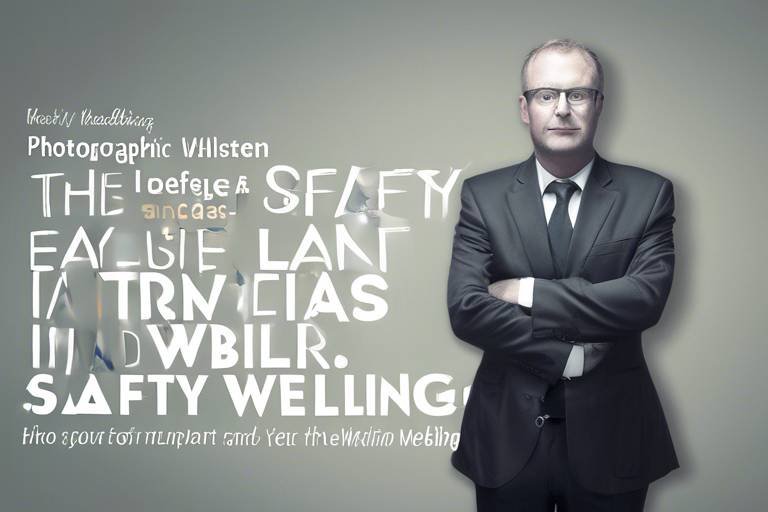Distracted Walking: A Modern Safety Risk
In today's fast-paced world, where everyone seems to be in a hurry, the act of walking has taken on a new dimension. Distracted walking is emerging as a significant safety concern, particularly in urban environments. With the rise of smartphones and social media, people are often more engrossed in their devices than aware of their surroundings. This behavior can lead to accidents, injuries, and even fatalities, making it crucial to understand the implications of distracted walking.
Imagine this: you're strolling down a busy street, and suddenly, someone walks straight into you, their eyes glued to their phone screen. This scenario has become all too common, and it highlights a growing trend that can no longer be ignored. As we explore the causes, consequences, and potential solutions to this issue, it's essential to recognize that distracted walking is not just an individual problem but a societal one.
At its core, distracted walking is about divided attention. When people are preoccupied with their mobile devices, they become less aware of their environment. This distraction can lead to a range of dangerous situations, from bumping into pedestrians to stepping into traffic without looking. The consequences can be dire, and the statistics are alarming.
As we delve deeper into this topic, we will uncover the various factors contributing to distracted walking, including the pervasive influence of smartphones and the modern culture of multitasking. By understanding these elements, we can work towards creating a safer environment for everyone.
Distracted walking refers to the act of walking while engaged in activities that divert attention, such as texting or using mobile devices. This behavior can lead to increased accidents and injuries. The phenomenon is not just about being careless; it reflects a broader cultural shift where technology and connectivity have become paramount. As we continue to integrate technology into our daily routines, it’s vital to consider how these changes affect our safety.
Several factors contribute to distracted walking, including the prevalence of smartphones, social media, and the desire to multitask. Understanding these causes can help address the issue effectively. Below are some of the primary reasons behind this modern dilemma:
- Smartphone Usage: The rise of smartphone usage has significantly impacted pedestrian safety. Users often prioritize their devices over their surroundings, leading to dangerous situations on the streets.
- Social Media Influence: Social media platforms encourage constant connectivity, prompting individuals to engage online even while walking. This behavior can distract pedestrians and increase the likelihood of accidents.
- Multitasking Behavior: Many individuals attempt to multitask while walking, such as reading emails or navigating. This divided attention can impair judgment and reaction times, resulting in hazardous situations.
Environmental elements, such as crowded sidewalks and urban settings, can exacerbate the risks associated with distracted walking. Awareness of surroundings is crucial in these environments to ensure safety. For instance, navigating through a bustling city requires not just physical movement but also mental vigilance. When pedestrians are distracted, they are more likely to overlook potential hazards like bicycles, cars, or even other pedestrians.
The consequences of distracted walking can be severe, ranging from minor injuries to fatal accidents. Understanding these risks is essential for promoting safer walking habits. The ramifications of being unaware while walking can lead to a cascade of negative outcomes, not just for the distracted individual but also for others around them.
Statistics indicate a rising trend in pedestrian injuries related to distracted walking. According to recent studies, the number of injuries has increased by over 30% in the last five years, with many of these incidents linked to smartphone usage. Awareness of these numbers can motivate individuals to adopt safer practices while on the move.
Distracted walking may lead to legal consequences, both for pedestrians and drivers. In some regions, laws are being enacted to hold distracted pedestrians accountable for their actions, promoting responsible behavior among all road users. Understanding these implications can encourage a culture of safety and responsibility.
Implementing preventative measures can significantly reduce the risks associated with distracted walking. Education and awareness campaigns play a vital role in promoting safer pedestrian practices. By working together, communities can foster an environment where safety is prioritized.
Public awareness campaigns aim to educate pedestrians about the dangers of distracted walking. These initiatives can foster a culture of safety and responsibility among individuals. For example, campaigns that highlight real-life stories of distracted walking incidents can resonate deeply and encourage people to think twice before using their devices while walking.
Innovative technology solutions, such as apps and wearable devices, can help mitigate distracted walking risks by providing alerts and reminders to stay aware of surroundings. Imagine a smartwatch that vibrates when you get too engrossed in your phone while walking; such solutions could be game-changers in promoting pedestrian safety.
Q: What is distracted walking?
A: Distracted walking refers to the act of walking while engaged in activities that divert attention, such as texting or using mobile devices.
Q: What are the main causes of distracted walking?
A: The primary causes include smartphone usage, social media influence, and multitasking behavior.
Q: What are the consequences of distracted walking?
A: Consequences can range from minor injuries to fatal accidents, and they can also lead to legal implications for both pedestrians and drivers.
Q: How can we prevent distracted walking?
A: Preventative measures include public awareness campaigns and technology solutions that encourage individuals to stay aware of their surroundings.

[Understanding Distracted Walking]
Distracted walking refers to the act of walking while engaged in activities that divert attention, such as texting, browsing social media, or using mobile devices. In our fast-paced world, where information is at our fingertips, it’s all too easy to lose focus on our immediate surroundings. Imagine walking through a bustling city, your eyes glued to your phone screen, completely unaware of the honking cars or the pedestrians around you. This behavior can lead to a significant increase in accidents and injuries, making it a pressing issue in today’s society.
As we delve deeper into the phenomenon of distracted walking, it’s essential to recognize how this seemingly innocuous habit can have serious consequences. The act of walking is often taken for granted; we do it every day without a second thought. However, when we allow distractions to take over, we compromise our safety. The consequences can range from minor scrapes and bruises to life-altering injuries. It's a bit like juggling while walking on a tightrope—one moment of distraction can lead to a fall.
Moreover, the environment plays a crucial role in exacerbating the risks associated with distracted walking. In crowded urban settings, where sidewalks are bustling with people, the stakes are even higher. The lack of awareness can lead to collisions, not just with other pedestrians but also with cyclists and vehicles. The combination of distractions and environmental factors creates a perfect storm for accidents. Thus, understanding distracted walking is not just about acknowledging the act itself; it’s about recognizing the broader implications it has on our safety and well-being.
To illustrate the growing concern surrounding this issue, let’s look at some alarming statistics. A recent study showed that pedestrian injuries have surged, particularly among those who engage in distracted walking. In fact, the National Highway Traffic Safety Administration (NHTSA) reported that pedestrian fatalities have increased by over 40% in the last decade, with a significant portion attributed to distractions. This data underscores the urgent need for awareness and action.
In conclusion, distracted walking is a modern safety risk that we cannot afford to ignore. As we navigate our busy lives, it’s crucial to remember that our safety should always come first. By understanding the nature of distracted walking and its potential consequences, we can take proactive steps to ensure a safer environment for ourselves and those around us.
- What is distracted walking? Distracted walking is when individuals engage in activities that divert their attention while walking, such as texting or using mobile devices.
- What are the risks associated with distracted walking? The risks include increased chances of accidents, injuries, and even fatalities due to a lack of awareness of surroundings.
- How can I stay safe while walking? To stay safe, avoid using your phone or engaging in other distractions while walking. Stay aware of your surroundings and follow pedestrian signals.
- Are there any technologies that can help? Yes, there are apps and wearable devices designed to alert users to their surroundings, helping to mitigate the risks of distracted walking.

[Causes of Distracted Walking]
Distracted walking is a growing concern in our fast-paced society, and several factors contribute to this alarming trend. One of the primary culprits is the ubiquity of smartphones. These devices have become an extension of ourselves, often taking precedence over our immediate surroundings. Imagine walking down a busy street, your eyes glued to your phone, completely unaware of the bustling world around you. This scenario is all too common, as people prioritize their devices over their safety.
Moreover, the influence of social media cannot be understated. Platforms like Instagram, Twitter, and Facebook encourage users to remain connected at all times, even when walking. The desire to capture the perfect selfie or respond to a friend's post often leads individuals to engage in online activities while navigating crowded sidewalks or busy intersections. This constant connectivity creates a perfect storm for accidents, as attention is diverted from the path ahead.
Another significant factor is the tendency to multitask. Many individuals believe they can efficiently juggle multiple tasks while walking, such as reading emails, checking messages, or even making phone calls. However, this divided attention severely impairs judgment and reaction times. Picture someone trying to read a text while crossing the street; they might miss a critical signal or an approaching vehicle, leading to potentially dangerous situations. The brain simply cannot focus on multiple tasks effectively, especially in environments that require constant awareness.
Environmental factors also play a crucial role in the risks associated with distracted walking. In urban settings where sidewalks are crowded and traffic is heavy, the need for awareness is heightened. When individuals are distracted by their devices, they become less attuned to their surroundings, increasing the likelihood of accidents. A crowded sidewalk can feel like navigating a maze, and without proper attention, it’s easy to trip, bump into others, or even step into traffic.
In summary, the causes of distracted walking are multifaceted, stemming from our reliance on technology, the influence of social media, and the tendency to multitask. As we continue to integrate our devices into our daily lives, understanding these causes is essential for addressing the issue effectively. By recognizing the distractions that come with modern life, we can take proactive steps to ensure our safety while walking.
- What is distracted walking? Distracted walking refers to the act of walking while engaging in activities that divert attention, such as texting or using mobile devices.
- Why is distracted walking a concern? It increases the risk of accidents and injuries, making it a significant safety issue in today's society.
- How can I avoid distracted walking? Stay aware of your surroundings, avoid using your phone while walking, and focus on your path to ensure safety.
- Are there any legal implications for distracted walking? Yes, distracted walking can lead to legal consequences for both pedestrians and drivers involved in accidents.

[Smartphone Usage]
The rise of smartphone usage has dramatically reshaped our daily lives, creating a landscape where our devices often take precedence over our surroundings. Think about it: how many times have you seen someone walking down the street, head bent over their phone, completely oblivious to the world around them? This phenomenon isn’t just a little distracting; it’s a serious safety concern. When pedestrians prioritize their phones—whether they’re checking social media, reading emails, or texting—they become less aware of potential hazards. This divided attention can lead to dangerous situations, such as walking into traffic, tripping over obstacles, or colliding with other pedestrians.
According to recent studies, a staggering percentage of pedestrian accidents can be attributed to smartphone distractions. In fact, a survey revealed that over 60% of respondents admitted to using their phones while walking. The allure of our devices is hard to resist, but the consequences can be dire. Just as a driver who is texting takes their eyes off the road, a pedestrian who is engrossed in their phone takes their eyes off the sidewalk and surrounding environment.
To illustrate the impact of smartphone usage on pedestrian safety, consider the following statistics:
| Year | Pedestrian Injuries Related to Smartphone Usage |
|---|---|
| 2018 | 1,000 |
| 2019 | 1,500 |
| 2020 | 2,200 |
| 2021 | 2,800 |
This table highlights a noticeable trend: as smartphone usage has increased, so have the number of pedestrian injuries related to distractions from these devices. It’s like a vicious cycle—more phones lead to less attention, which in turn leads to more accidents. The simple act of walking, something we often take for granted, becomes fraught with danger when we allow our smartphones to hijack our focus.
In addition to the physical dangers, there’s also an emotional toll. Imagine the feeling of being involved in an accident that could have been easily avoided had you just paid attention to your surroundings. The guilt and anxiety can linger long after the incident. It’s a wake-up call for all of us to reconsider how we engage with our smartphones while on the move. So, how do we strike a balance? How can we enjoy our devices without putting ourselves at risk?
Ultimately, it’s about making conscious choices. Setting your phone to “Do Not Disturb” mode while walking, using hands-free devices for calls, or even taking a moment to pause before engaging with your phone can make a world of difference. Remember, the world around you is just as important as the notifications lighting up your screen. Let’s reclaim our attention and make our sidewalks safer for everyone.
- What is distracted walking? Distracted walking refers to the act of walking while engaged in activities that divert attention, such as texting or using mobile devices.
- How can I stay safe while walking and using my smartphone? Consider putting your phone away or using hands-free options. Stay aware of your surroundings, and avoid engaging with your device while crossing streets.
- Are there any apps that can help with distracted walking? Yes, some apps provide reminders to stay aware of your surroundings or even alert you when you are approaching potential hazards.

[Social Media Influence]
In today's hyper-connected world, social media plays an undeniable role in our daily lives. It’s almost as if we have become addicted to our devices, constantly refreshing our feeds to stay updated on everything from friend’s brunch photos to trending news. This incessant need to engage with social platforms can significantly impair our ability to stay aware of our surroundings while walking. How many times have you seen someone walking down the street, head down, eyes glued to their screens, completely oblivious to the world around them? It's a common sight, and it raises a crucial question: at what cost does our connectivity come?
Social media platforms like Instagram, Facebook, and Twitter encourage users to share their experiences in real-time. This constant need to post updates or respond to notifications can lead to a dangerous habit of distracted walking. Research shows that individuals engaged in social media interactions while walking are more likely to encounter obstacles, such as pedestrians, cyclists, or even vehicles. The allure of a like or comment can easily overshadow the immediate dangers of the environment.
Moreover, the fear of missing out (FOMO) can compel individuals to check their phones while in transit. Imagine this: you're walking to meet friends, but you can't help but check your notifications every few seconds. Suddenly, you're not just walking; you’re navigating a maze of distracted drivers and other pedestrians, all while trying to stay updated online. This kind of behavior not only increases the risk of accidents but also diminishes the overall experience of being present in the moment.
To illustrate the impact of social media on distracted walking, consider the following statistics:
| Year | Pedestrian Accidents Due to Distraction | Percentage Increase |
|---|---|---|
| 2018 | 1,000 | - |
| 2019 | 1,250 | 25% |
| 2020 | 1,500 | 20% |
| 2021 | 1,800 | 20% |
This table highlights a troubling trend: as social media use has increased, so have pedestrian accidents related to distraction. The numbers speak for themselves, and they should serve as a wake-up call to all of us. It’s crucial to recognize that while social media can keep us connected, it can also create a false sense of security that leads to dangerous situations.
In conclusion, the influence of social media on distracted walking is profound and multifaceted. It encourages a culture of constant engagement that, while rewarding in terms of social interaction, can lead to dire consequences on the streets. As we become more aware of this issue, we must strive to find a balance between staying connected online and being present in our physical environments. After all, no tweet or post is worth risking your safety.
- What is distracted walking? Distracted walking refers to the act of walking while engaged in activities that divert attention, such as texting or using mobile devices.
- How does social media contribute to distracted walking? Social media encourages constant connectivity, prompting individuals to engage online even while walking, which can distract pedestrians and increase the likelihood of accidents.
- What can be done to prevent distracted walking? Implementing public awareness campaigns and using technology solutions like apps that promote safe walking habits can help mitigate the risks.

[Multitasking Behavior]
In our fast-paced world, multitasking has become a badge of honor, a way to showcase our ability to juggle multiple tasks at once. However, when it comes to walking, this behavior can be particularly dangerous. Many individuals feel compelled to check their emails, scroll through social media, or even respond to text messages while on the move. This tendency to split our focus not only puts our safety at risk but can also lead to a myriad of accidents.
Imagine this: you’re walking down a busy street, and your phone buzzes with a notification. Your instinct is to pull it out and check it, right? But what happens next? You lose track of your surroundings. You might bump into someone, trip over a crack in the sidewalk, or, worse yet, step into the path of an oncoming vehicle. Research has shown that multitasking while walking can significantly impair your judgment and reaction times, making you more susceptible to accidents.
To illustrate the impact of multitasking on walking safety, consider the following statistics:
| Activity | Injury Risk Increase |
|---|---|
| Texting | 50% |
| Reading Emails | 40% |
| Using Social Media | 30% |
As you can see, engaging in these common activities while walking can substantially increase your risk of injury. The reality is that our brains are not wired to handle multiple tasks effectively, especially when one of them demands our full attention, like navigating through crowded streets. Just like trying to watch a movie while simultaneously reading a book, you end up missing the key details of both.
Furthermore, the desire to multitask often stems from our need to feel productive. We live in a culture that glorifies being busy, but this mindset can lead to dangerous consequences. Instead of focusing on the task at hand—walking safely—our minds are divided, and our bodies follow suit. It’s crucial to recognize that walking is not just a means of transportation; it’s an activity that requires our full attention, especially in urban environments where hazards abound.
So, what can we do to combat this urge to multitask while walking? Here are a few strategies:
- Set Boundaries: Designate specific times for checking your phone instead of doing it while walking.
- Be Present: Practice mindfulness by focusing on your surroundings, appreciating the sights and sounds around you.
- Use Technology Wisely: Consider using apps that limit notifications while you’re on the move.
In conclusion, while multitasking may seem like a necessary skill in our modern lives, it is essential to recognize its limitations, especially when it comes to walking. By prioritizing our safety and being fully present in the moment, we can significantly reduce the risks associated with distracted walking.
- What is distracted walking? Distracted walking refers to walking while engaged in activities that divert attention, such as texting or using mobile devices.
- Why is multitasking while walking dangerous? Multitasking can impair judgment and reaction times, increasing the likelihood of accidents.
- How can I stay safe while walking? Focus on your surroundings, set boundaries for phone usage, and practice mindfulness to enhance safety.

[Environmental Factors]
The environment in which we walk plays a significant role in the risks associated with distracted walking. Urban areas, with their bustling crowds and vibrant activities, can be a double-edged sword. On one hand, these lively settings can invigorate our senses; on the other, they can create a chaotic atmosphere that demands our full attention. When pedestrians are glued to their smartphones, they may overlook crucial cues in their surroundings, leading to potentially dangerous situations.
Crowded sidewalks, for instance, can present a myriad of hazards. When navigating through throngs of people, the last thing you want is to be distracted by a notification on your phone. Imagine trying to walk through a busy market while scrolling through social media; it’s a recipe for disaster! The lack of personal space and the unpredictability of other pedestrians can easily lead to collisions or falls.
Moreover, environmental factors such as poor lighting conditions, weather changes, and uneven pavement can further complicate the situation. For example, walking in dimly lit areas while distracted can increase the likelihood of tripping or not noticing an approaching vehicle. Similarly, rainy or snowy weather can make sidewalks slippery, requiring heightened awareness that is often compromised by the allure of our digital devices. This is why it’s crucial to remain vigilant and mindful of our surroundings, especially in urban settings where distractions abound.
To illustrate the impact of environmental factors on distracted walking, consider the following table that outlines various environmental elements and their potential effects:
| Environmental Factor | Potential Effect on Distracted Walking |
|---|---|
| Crowded Sidewalks | Increased risk of collisions and falls |
| Poor Lighting | Higher chances of tripping and not seeing hazards |
| Weather Conditions | Slippery surfaces leading to accidents |
| Uneven Pavement | Increased risk of falls and injuries |
In conclusion, the interplay between our environment and distracted walking cannot be underestimated. As we navigate through our daily lives, it’s essential to remain aware of not just our immediate surroundings but also the broader environmental factors that can influence our safety. By cultivating a habit of mindfulness, we can significantly reduce the risks associated with distracted walking and ensure a safer experience for ourselves and those around us.
- What is distracted walking? Distracted walking refers to the act of walking while engaged in activities that divert attention, such as texting or using mobile devices.
- How does the environment influence distracted walking? Environmental factors like crowded sidewalks, poor lighting, and weather conditions can increase the risks associated with distracted walking by creating hazardous situations.
- What can be done to reduce distracted walking? Implementing public awareness campaigns, using technology solutions, and fostering a culture of mindfulness can significantly reduce the risks of distracted walking.

[Consequences of Distracted Walking]
The consequences of distracted walking can be both alarming and far-reaching, affecting not only the individual but also the broader community. When pedestrians allow their attention to drift away from their surroundings, they open themselves up to a myriad of risks. These risks can range from minor scrapes and bruises to severe injuries or even fatalities. It's essential to grasp the potential outcomes of this behavior to foster a culture of safety and awareness.
Statistics reveal a troubling trend in pedestrian injuries linked to distracted walking. According to recent studies, distracted walking incidents have surged by over 30% in the past few years. This dramatic increase highlights the urgent need for individuals to recognize the dangers associated with being preoccupied while walking. For instance, a report from the National Highway Traffic Safety Administration (NHTSA) indicates that distracted walking contributed to nearly 6,000 pedestrian fatalities in the United States alone in 2021. These numbers are not just statistics; they represent real lives affected by a moment of inattention.
| Year | Pedestrian Fatalities | Increase in Distracted Walking Incidents |
|---|---|---|
| 2019 | 6,205 | N/A |
| 2020 | 6,721 | 15% |
| 2021 | 7,342 | 30% |
Beyond physical injuries, distracted walking can also lead to legal implications. Pedestrians who are distracted may inadvertently violate traffic laws, putting themselves at risk of fines or legal action. Moreover, if a distracted pedestrian causes an accident, they could face serious repercussions, including liability for damages. This not only affects the pedestrian but can also have significant consequences for drivers involved in these incidents.
In addition to the legal and physical consequences, there are emotional and psychological impacts to consider. Individuals who experience accidents due to distracted walking may suffer from anxiety or fear of walking in similar situations in the future. This can lead to a cycle of avoidance, where the individual becomes increasingly reliant on vehicles for transportation, further reducing physical activity and contributing to an unhealthy lifestyle.
In conclusion, the consequences of distracted walking are multifaceted and can have profound effects on individuals and communities alike. By understanding the risks associated with this behavior, we can begin to take steps towards fostering a safer environment for all pedestrians. Awareness is the first step, but it must be coupled with action to ensure that our streets are safe for everyone.
- What is distracted walking? Distracted walking refers to walking while engaged in activities that divert attention, such as texting or using mobile devices.
- What are the main causes of distracted walking? The primary causes include smartphone usage, social media influence, and the tendency to multitask.
- How can I avoid distracted walking? Stay aware of your surroundings, limit phone use while walking, and prioritize safety over multitasking.
- What are the legal implications of distracted walking? Distracted walking can lead to fines or legal action if it results in violations of traffic laws or accidents.

[Injury Statistics]
When we talk about distracted walking, it’s not just a casual concern; it’s a growing epidemic that has serious implications for pedestrian safety. Recent studies have shown a staggering increase in injuries related to this behavior. In fact, the National Highway Traffic Safety Administration (NHTSA) reports that pedestrian injuries have risen by over 30% in the last five years alone, with a significant portion attributed to distractions caused by smartphones and other devices.
To put this into perspective, let’s consider some eye-opening statistics:
| Year | Injuries from Distracted Walking | Percentage Increase |
|---|---|---|
| 2018 | 4,300 | N/A |
| 2019 | 5,000 | 16.3% |
| 2020 | 5,500 | 10% |
| 2021 | 6,000 | 9.1% |
| 2022 | 6,500 | 8.3% |
This table illustrates the alarming trend: as more people become engrossed in their devices while walking, the number of injuries continues to escalate. Moreover, the consequences of these distractions are not just limited to minor accidents. According to the Centers for Disease Control and Prevention (CDC), distracted walking can lead to severe injuries, including fractures, concussions, and even fatalities.
But why does this happen? When individuals are focused on their screens, they often fail to notice their surroundings, leading to dangerous situations such as:
- Collisions with vehicles
- Trips and falls on uneven surfaces
- Injuries from running into obstacles like street furniture or other pedestrians
It’s crucial to understand that these injuries not only affect the individuals involved but also have broader societal implications, including increased healthcare costs and public safety concerns. Communities are now facing the challenge of addressing this issue head-on, and awareness is the first step towards change.
By fostering a culture of safety and encouraging pedestrians to remain vigilant, we can work towards reducing these alarming statistics. The next time you walk down the street, ask yourself: Is checking my phone really worth the risk? The answer is clear—prioritizing safety is essential for everyone.
Q: What are the main causes of distracted walking?
A: The primary causes include smartphone usage, social media engagement, and multitasking while walking.
Q: How can I stay safe while walking?
A: Stay aware of your surroundings, avoid using your phone while walking, and consider using hands-free devices if necessary.
Q: Are there any laws regarding distracted walking?
A: While specific laws vary by location, some areas have implemented regulations that penalize pedestrians for using devices while crossing streets.

[Legal Implications]
The rise of distracted walking has not only become a pressing safety concern but has also introduced a complex web of legal implications for both pedestrians and drivers. As more individuals engage in activities like texting or scrolling through social media while walking, the lines of responsibility in the event of an accident can become blurred. Who is at fault? Is it the distracted pedestrian, the driver who failed to stop in time, or perhaps even the smartphone manufacturer for creating such engaging devices? These questions are increasingly relevant in today's legal landscape.
In many jurisdictions, laws exist that hold pedestrians accountable for their actions while crossing streets or navigating public spaces. For instance, if a pedestrian is found to be distracted and subsequently causes an accident, they may be deemed partially or fully liable. This could lead to significant legal consequences, including fines or even civil lawsuits. Moreover, if a driver is involved in an accident with a distracted pedestrian, they may also face legal repercussions, especially if they are found to be speeding or not paying adequate attention to their surroundings.
To illustrate the gravity of these legal implications, consider the following statistics:
| Year | Pedestrian Accidents | Legal Cases Filed |
|---|---|---|
| 2020 | 6,000+ | 1,200 |
| 2021 | 7,500+ | 1,500 |
| 2022 | 8,200+ | 1,800 |
These numbers highlight a concerning trend: as distracted walking increases, so do the accidents and the subsequent legal cases. This escalation calls for a greater understanding of the laws surrounding pedestrian conduct and the responsibilities of drivers. In many areas, pedestrian safety laws mandate that pedestrians should remain alert and aware of their surroundings, which includes avoiding distractions like mobile devices.
Furthermore, the legal implications extend beyond immediate accidents. Insurance companies may also scrutinize claims involving distracted walking. If a pedestrian is injured while walking and is found to have been distracted, their compensation could be significantly reduced. In some cases, they might even be denied coverage altogether, leading to financial strain and legal battles over liability and compensation.
Ultimately, understanding the legal implications of distracted walking is crucial for everyone on the road. It serves as a reminder that while technology can enhance our lives, it can also pose significant risks. **Pedestrians and drivers alike must prioritize safety and awareness to navigate the complexities of modern urban environments.**
As we move forward in addressing this issue, it’s essential to foster a culture of responsibility among all road users. By recognizing the potential legal consequences of distracted walking, individuals can make more informed choices that not only protect themselves but also contribute to the overall safety of our communities.
- What is distracted walking? Distracted walking refers to the act of walking while engaged in activities that divert attention, such as texting or using mobile devices.
- Can pedestrians be held liable for accidents? Yes, in many jurisdictions, pedestrians can be held partially or fully liable if they are found to be distracted at the time of an accident.
- What are the potential legal consequences for distracted walking? Legal consequences can include fines, civil lawsuits, and complications with insurance claims.
- How can I stay safe while walking? Stay aware of your surroundings, avoid using your phone while walking, and follow pedestrian safety laws.

[Preventative Measures]
To combat the rising trend of distracted walking, it's essential to implement a variety of preventative measures that can significantly reduce risks. One of the most effective strategies is education. By raising awareness about the dangers associated with distracted walking, individuals can be encouraged to adopt safer habits. Public awareness campaigns can play a crucial role in this regard. These campaigns can be conducted through various channels, including social media, community events, and schools, where the focus is on teaching pedestrians about the importance of staying alert while walking.
Moreover, it's vital to consider the role of technology in enhancing pedestrian safety. Innovative solutions like mobile applications and wearable devices can serve as reminders for individuals to pay attention to their surroundings. For instance, apps can send notifications when a user is walking and using their phone, prompting them to be more mindful of their environment. Such technological interventions can be a game changer, especially for younger generations who are often glued to their screens.
Another effective measure is the design of urban spaces. City planners can create pedestrian-friendly environments that encourage safe walking practices. This includes well-designed crosswalks, adequate lighting, and clear signage that remind pedestrians to stay alert. Additionally, implementing dedicated walking zones can help minimize distractions. For example, areas that restrict mobile device usage or encourage walking without distractions can foster a culture of safety.
Incorporating community engagement is also key to promoting safer walking. Local organizations can host workshops or events that focus on pedestrian safety, teaching individuals how to navigate busy streets without falling prey to distractions. By involving the community, the message of safety can resonate more deeply, creating a collective responsibility among residents.
| Measure | Description | Potential Impact |
|---|---|---|
| Education Campaigns | Informing the public about the dangers of distracted walking. | Increased awareness and safer walking habits. |
| Technology Solutions | Apps and devices that alert users when they are distracted. | Reduced incidents of distracted walking. |
| Urban Design | Creating pedestrian-friendly environments. | Enhanced safety for pedestrians. |
| Community Engagement | Workshops and events focused on pedestrian safety. | Stronger community commitment to safety. |
In conclusion, a multifaceted approach is necessary to tackle the issue of distracted walking effectively. By combining education, technology, urban planning, and community involvement, we can create a safer environment for pedestrians. It’s not just about avoiding accidents; it’s about fostering a culture where safety is prioritized, and awareness is second nature. So, the next time you step outside, remember to put your phone down and stay aware of your surroundings. After all, your safety is worth it!
Q1: What is distracted walking?
A1: Distracted walking refers to the act of walking while engaging in activities that divert attention, such as texting or using mobile devices.
Q2: What are the main causes of distracted walking?
A2: The main causes include smartphone usage, social media influence, and the tendency to multitask while walking.
Q3: How can I prevent distracted walking?
A3: You can prevent distracted walking by staying aware of your surroundings, using technology wisely, and participating in community safety programs.
Q4: Are there legal implications for distracted walking?
A4: Yes, distracted walking can lead to legal consequences for both pedestrians and drivers if accidents occur.

[Public Awareness Campaigns]
Public awareness campaigns play a crucial role in addressing the growing issue of distracted walking. These initiatives are designed to educate pedestrians about the risks associated with using mobile devices while navigating through busy streets. By raising awareness, these campaigns aim to foster a culture of safety and responsibility among individuals. Think of it as a modern-day public service announcement, where the goal is to get people to put their phones down and pay attention to their surroundings.
One of the most effective ways to engage the public is through visual storytelling. Campaigns often utilize eye-catching graphics, videos, and social media posts to illustrate the dangers of distracted walking. For instance, a powerful video might show the stark contrast between a pedestrian glued to their phone and another who is aware of their environment, highlighting the potential consequences of inattention. This not only captures attention but also makes the message resonate on a personal level.
Moreover, community involvement is essential for the success of these campaigns. Local organizations, schools, and businesses can collaborate to spread the word through events, workshops, and even contests. For example, a local high school might host a "Walk Without Your Phone" day, encouraging students to experience how it feels to navigate their campus without distractions. Such activities can create a buzz and encourage participation, making the message more relatable and impactful.
To measure the effectiveness of these awareness campaigns, it’s vital to track changes in behavior and accident statistics. A well-structured campaign should include a feedback mechanism that allows participants to share their experiences and insights. This data can then be used to refine future initiatives, ensuring that the campaigns remain relevant and effective.
In summary, public awareness campaigns serve as a powerful tool in combating distracted walking. By employing creative strategies and fostering community involvement, these initiatives can help instill safer walking habits. After all, the goal is not just to inform but to inspire change. So, the next time you step outside, remember to keep your head up and stay aware—your safety is worth it!
- What is distracted walking? Distracted walking refers to the act of walking while engaged in activities that divert attention, such as texting or using mobile devices.
- How can I avoid distracted walking? To avoid distracted walking, try keeping your phone in your pocket or bag while walking, and make a conscious effort to stay aware of your surroundings.
- Are there any laws regarding distracted walking? While laws vary by location, some places have implemented regulations to penalize pedestrians who are distracted while crossing streets.
- What are the consequences of distracted walking? The consequences can range from minor injuries to fatal accidents, making it essential to stay vigilant while walking.
- How can I participate in awareness campaigns? You can participate by joining local events, sharing information on social media, or volunteering with organizations focused on pedestrian safety.

[Technology Solutions]
In our fast-paced world, where smartphones have become an extension of ourselves, addressing the issue of distracted walking with innovative technology solutions is not just smart—it's essential. Various applications and devices have emerged that aim to keep pedestrians aware of their surroundings, significantly reducing the risks associated with distracted walking. Imagine walking down a busy street, engrossed in your phone, when suddenly an app alerts you to an approaching vehicle or a pedestrian crossing ahead. This is the reality that technology can offer.
One of the most promising solutions comes in the form of mobile applications designed specifically to combat distracted walking. These apps often utilize the phone's camera and sensors to detect obstacles in the user's path. For instance, some applications will employ augmented reality (AR) to overlay important information onto the real world, making it impossible to miss crucial details while still keeping your eyes on the road. Furthermore, many of these apps come with customizable alert settings, allowing users to choose how they want to be notified—be it through vibrations, sounds, or visual cues.
Additionally, wearable technology is making waves in pedestrian safety. Devices like smartwatches and fitness bands can be programmed to send alerts when the wearer is distracted. For example, if the user is walking and their heart rate increases due to a sudden need to react to an obstacle, the device can vibrate to remind them to pay attention. This proactive approach not only enhances safety but also encourages users to be more mindful of their surroundings.
Moreover, some cities are adopting smart infrastructure that integrates technology into the urban environment. This includes smart traffic signals that change based on pedestrian movement patterns and alert systems that communicate with mobile devices. For example, a pedestrian waiting at a crosswalk might receive a notification on their phone when it's safe to cross, thus reducing the temptation to check their device while walking.
To illustrate the impact of technology on distracted walking, consider the following table that summarizes various technology solutions and their benefits:
| Technology Solution | Description | Benefits |
|---|---|---|
| Mobile Applications | Apps that use camera and sensors to detect obstacles | Alerts users to hazards, enhances awareness |
| Wearable Devices | Smartwatches that provide alerts based on user behavior | Encourages mindfulness, proactive safety |
| Smart Infrastructure | City systems that adapt to pedestrian movement | Improves traffic flow, enhances safety |
While technology offers innovative solutions to the problem of distracted walking, it is essential to remember that these devices are not a substitute for personal responsibility. Users must remain vigilant and aware of their surroundings, even when equipped with the latest tech. The combination of technology and personal awareness can create a safer walking environment for everyone.
- What is distracted walking? Distracted walking refers to the act of walking while engaged in activities that divert attention, such as texting or using mobile devices.
- How can technology help with distracted walking? Technology can provide alerts, reminders, and real-time information about surroundings, helping pedestrians stay aware of potential hazards.
- Are there any apps specifically designed for pedestrian safety? Yes, there are several apps available that focus on enhancing pedestrian safety by alerting users to obstacles and hazards.
- What role do wearable devices play in preventing distracted walking? Wearable devices can monitor user behavior and provide alerts to encourage mindfulness and awareness while walking.
Frequently Asked Questions
- What is distracted walking?
Distracted walking refers to the act of walking while engaging in activities that divert your attention, like texting or using a smartphone. This behavior can lead to accidents and injuries as people often overlook their surroundings.
- What are the main causes of distracted walking?
Several factors contribute to distracted walking, including the widespread use of smartphones, the influence of social media, and the tendency to multitask. Each of these elements can pull our focus away from the path ahead, increasing the risk of accidents.
- How does smartphone usage affect pedestrian safety?
The rise of smartphone usage has significantly impacted pedestrian safety. Many users prioritize their devices over their surroundings, often leading to dangerous situations on the streets, such as collisions with vehicles or other pedestrians.
- What role does social media play in distracted walking?
Social media platforms encourage constant connectivity, prompting individuals to engage online even while walking. This distraction can impair their ability to notice potential hazards, increasing the likelihood of accidents.
- Are there any statistics on distracted walking injuries?
Yes, statistics show a rising trend in pedestrian injuries related to distracted walking. Awareness of these numbers can motivate individuals to adopt safer practices while on the move to protect themselves and others.
- What are the legal implications of distracted walking?
Distracted walking can lead to legal consequences for both pedestrians and drivers. Understanding these implications encourages responsible behavior among all road users, promoting safety for everyone on the streets.
- How can we prevent distracted walking?
Implementing preventative measures, such as public awareness campaigns and innovative technology solutions, can significantly reduce the risks associated with distracted walking. Education plays a vital role in promoting safer pedestrian practices.
- What types of technology can help mitigate distracted walking?
Innovative technology solutions, like apps and wearable devices, can help by providing alerts and reminders to stay aware of surroundings, ultimately promoting safer walking habits.



















